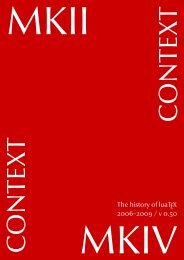ConTEXt an excursion - Pragma ADE
ConTEXt an excursion - Pragma ADE
ConTEXt an excursion - Pragma ADE
You also want an ePaper? Increase the reach of your titles
YUMPU automatically turns print PDFs into web optimized ePapers that Google loves.
Defining comm<strong>an</strong>ds / macros<br />
Without <strong>an</strong>y further expl<strong>an</strong>ation this comm<strong>an</strong>d is used in the following example.<br />
You may have a well illustrated document <strong>an</strong>d you are tired of typing:<br />
\placefigure<br />
[here,force]<br />
[fig:logical name]<br />
{Caption.}<br />
{\externalfigure[filename][width=5cm]}<br />
You could define your own comm<strong>an</strong>d with a few variables like:<br />
contents<br />
index<br />
comm<strong>an</strong>ds<br />
definitions<br />
colofon<br />
• logical name<br />
• caption<br />
• file name<br />
Your comm<strong>an</strong>d definition <strong>an</strong>d call could look something like this:<br />
\define[3]\myputfigure<br />
{\placefigure<br />
[here,force][fig:#1]<br />
{#2}{\externalfigure[#3][width=5cm]}}<br />
\myputfigure{lion}{The Dutch lion is a sentry.}{hass13g}<br />
Between brackets [3] indicates that you w<strong>an</strong>t to use three variables #1, #2 <strong>an</strong>d #3. In<br />
the comm<strong>an</strong>d call \myputfigure you have to input these variables between curly braces.<br />
The result would be:<br />
Very sophisticated comm<strong>an</strong>ds c<strong>an</strong> be programmed but this is left to your own inventiveness.<br />
In addition to defining comm<strong>an</strong>ds you c<strong>an</strong> also define \start · · · \stop comm<strong>an</strong>d pairs.<br />
\definestartstop[...][..,..=..,..]<br />
exit<br />
search +<br />
go back<br />
For example:<br />
– +<br />
36 106
















